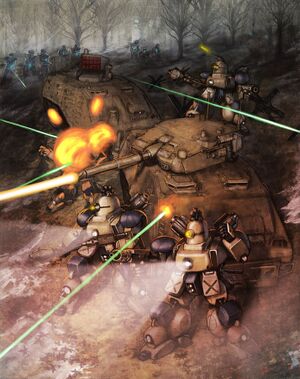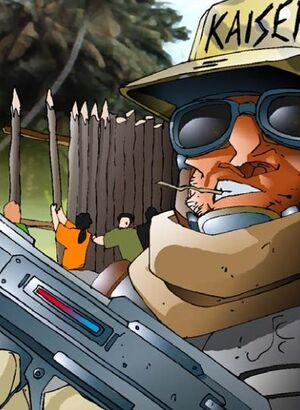MILICIA
In stark contrast to the shining ranks of the SRA, the MILitary Intervention and Counter-Insurgency Army (MILICIA) stands as a testament to the ugly nature of war and the people chosen to wage it. The MILICIA was formed to staff border outposts, prosecute counter-insurgency actions against the Southern Republic’s member states, and to handle various tasks deemed too demeaning and dishonorable for the SRA.
Thus, the MILICIA is subordinate to the SRA high command, and it is not uncommon for the SRA to use MILICIA forces as garrison troops and cannon fodder to reduce the losses to its own forces. Where enlistment in the SRA is viewed with pride, enlistment in the MILICIA is considered something of a last resort — it implies that one is so bereft of skills and ability that the only thing the recruit has left to give is life itself.
The MILICIA draws its recruits from all member states of the AST, creating a melting pot of personnel from all manner of cultures and social strata. While the SRA acknowledges even its basic troops as worthy of respect, the MILICIA cleaves strongly to the idea that its enlisted men are underlings, and consequently there is a massive divide between the rank and file and their commanders. This is further reinforced by the MILICIA’s policy of using convict troops, capital criminals assigned to the frontlines as a form of prolonged death sentence. Thus, all MILICIAmen tend to be viewed as scum, whatever their origin. Ironically, this division serves to unite the men, even if only against those officers who have the power of life and death over them. The officers themselves aspire to recognition, fame, and power like officers of the SRA command, but only a few realize that they will never be treated as equals by the lofty SRA.
Though half the size of the SRA, the MILICIA commands far fewer resources (particularly armored assets) in proportion to its size. Funding is provided by involuntary contributions from the vassal leagues’ budgets and levying a military tax on many non-essential items. Matters are complicated by the rampant corruption in the MILICIA’s ranks, which further reduces the resources available to it. As a result, the MILICIA has had to become very innovative to survive, and foraging is a common means of supplementing meager rations and supplies. Foraging generally ranges from extracting a food tax from the natives to ward off misconduct from the MILICIAmen, to scrounging the necessary comestibles from the civilian populace, to outright armed robbery of the same. As territory becomes more hostile, MILICIA foraging tends toward the latter. This obligate frugality also informs the outfitting of the MILICIA.
Without the resources or funds to keep most equipment in good repair, let alone keep pace with the state of the art, MILICIA weapons and vehicles tend to be leftovers from older conflicts and usually in poor condition. Heavily cannibalized and modified vehicles such as Asps and stripped-down Jägers are a common sight in MILICIA Gear cadres, these sacrificing an extra weapons system (which would mean more ammunition and repair required) and relying on the Jäger’s built-in toughness and redundancy to provide a comparatively cheap and functional combat machine.
The melting pot nature of the MILICIA guarantees a diverse mix of personnel who are forced to work together. This necessarily creates teamwork problems until recruits become used to one another, but once that happens, the breadth of shared experience often becomes an invaluable asset in facing unusual circumstances and threats. That said, all MILICIAmen know that they are expendable, and this knowledge wreaks havoc on morale. Matters are only compounded by the MILICIA’s duties as riot police, where the rioters tend to be about as heavily armed as its soldiers are. The extreme measures needed to maintain order do not endear the MILICIA to many parties.


